Archive for the ‘NFL’ Category
January 12, 2016
No matter where your allegiance lies insofar as Manufacturer when it comes to “Collector Vehicles”, there are certain vehicles that can transcend mere bias. Everyone involved with the “collector hobby” realizes that some vehicles are to be added to any collection if they become available.
Whether it is a post-war “Woodie” wagon, or maybe a Cadillac Convertible or even a “suicide door Lincoln” you simply add the piece when you run across it.
Rarely do I make predictions for the road ahead in “collector vehicles” other than to point out the inherent rise in values for the overall health of the marketplace. However…. 2016 could prove to be the best “buyers market” since the economic collapse after 2007/2008.
I refer of course to the fall in the “oil market”. The number of collectors in classic vehicles throughout the Texas/Oklahoma region have been almost immune to the “recession”. If you follow Mecum Auctions as I do you have seen the Dallas and Houston Auctions remain impervious to the trend down in value during the recession. That is about to change. With millions and even billions of dollars of value being lost in the energy sector those who count on the income will need to “thin the herd” as far as their collections. Make no mistake, the oil sector contains a great amount of car hobbyists. It is, was and always has been a direct tie-in. That means the values at auction will be down this year (and possibly for a couple after that) and the buyers with spendable cash will be down as well. This puts the Dallas/Houston Auctions on a level field with values across the nation. And that is great news for collectors in other areas of the nation.
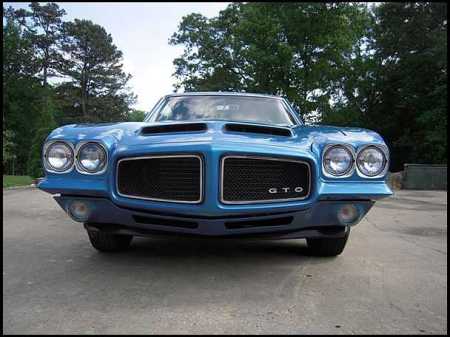
I am not saying the value of cars everywhere will be down to the extent of what runs through Texas this year. And I am not predicting falling values in the market. I am saying the “overprice factor” of the past Texas marketplace will be going away for a while. So whether you lean towards a 1946 Pontiac Streamliner Woodie Wagon or more towards a 
1970 Pontiac GTO Judge (Blue) or 1971 GTO Judge (Red) you need not ignore the Texas Auctions as in years past.
Davey Boy
Tags:1970, 1971, 400, 455, Automobiles, cars, Chicago, Dallas, GTO, high return, Houston, investments, making money, Mecum, money, Muscle Cars, Pontiac, Ram Air
Posted in Auctions, Automobiles, cars, current events, Investments, Muscle Cars, NFL, prototype cars, show cars, Uncategorized | Leave a Comment »
December 29, 2015
 When the final year for the “original style Camaro came around the model year was 1969, and despite the “454” emblems on the pictured car it was not a “factory choice” back then. The cubic inch limit remained the 396 for big blocks other than a handful of “COPO vehicles” that snuck through.
When the final year for the “original style Camaro came around the model year was 1969, and despite the “454” emblems on the pictured car it was not a “factory choice” back then. The cubic inch limit remained the 396 for big blocks other than a handful of “COPO vehicles” that snuck through.
 For the redesign in 1970 (technically known as 1970 1/2 for collectors) not everyone liked the new style. Production had been 230,799 Camaros for 1969 and fell to 117,604 for 1970. Collectors all try to explain the big drop to a limited production run due to a labor strike, but facts are that the 1971 production fell to 107,496 and then in 1972 it went even lower to 68,656. So no matter if you are a fan of the redesign or not- most buyers at that time were not.
For the redesign in 1970 (technically known as 1970 1/2 for collectors) not everyone liked the new style. Production had been 230,799 Camaros for 1969 and fell to 117,604 for 1970. Collectors all try to explain the big drop to a limited production run due to a labor strike, but facts are that the 1971 production fell to 107,496 and then in 1972 it went even lower to 68,656. So no matter if you are a fan of the redesign or not- most buyers at that time were not.
The reason I bring any of this up is due to the age old argument about the “fat Mustang years”. The redesign of the Camaro added 2 inches to the overall length yet people say the Camaro got much bigger. Maybe they were referring to the .4 (less than 1/2 an inch) increase in width. The one loss with the changeover was that Camaro no longer came in a convertible style.

For the Mustang its final year for the “Original style” (yes, technically there had been redesigns before) was 1970. The designers needed a larger engine compartment for the available engine choices and decided to make the car seem larger to compete with the true “Muscle Cars”. Basically it was time for the Mustang to grow up.
 Their new design was this. 1 inch more in wheelbase; it was now 109 instead of 108. (The Camaro did not change their wheelbase from the 108 in 1969.) Where it grew ever slightly was also the overall length- from 187.4 inches to 190 even. The biggest gain was the width from 71.7 to 75. All that rear sheetmetal also raised the base weight almost 180 pounds. The look made the Mustang seem much larger than it really was. To buyers or those who test drove it there were glaring deficiencies with the design.
Their new design was this. 1 inch more in wheelbase; it was now 109 instead of 108. (The Camaro did not change their wheelbase from the 108 in 1969.) Where it grew ever slightly was also the overall length- from 187.4 inches to 190 even. The biggest gain was the width from 71.7 to 75. All that rear sheetmetal also raised the base weight almost 180 pounds. The look made the Mustang seem much larger than it really was. To buyers or those who test drove it there were glaring deficiencies with the design.
You sat down much lower it seemed in the seat and the dash was higher and with the taller roofline and those huge rear quarters there was a severe blindspot. Add the angle of the rear window and the rear view through the mirror was as if you were looking through a gun slot in a tank.
The redesign for the Mustang also saw production fall from 1970 (197,046) to 1971 (149,628) to 1972 (125,093). Despite what many “Collectors” consider ugly years for the Mustang it still outsold everything in its class (Pony Cars) just as it had since the model was introduced halfway through 1964. And it did so by impressive margins. Today because of those production numbers you can buy a Mustang for about half of what a Camaro goes for. And that will continue to earn the Mustang “collector status”.
Davey Boy
Tags:1969, 1970, 1971, Automobiles, Camaro, cars, Chevrolet, Chicago, Ford, high return, investments, money, Muscle Cars, Mustang
Posted in Auctions, Automobiles, cars, current events, Investments, Muscle Cars, NFL, prototype cars, Racing, show cars, Uncategorized | Leave a Comment »
December 27, 2015
For the past year (2015) I have been rather preoccupied with issues that have sidetracked my pursuit of Muscle Cars. While I have bought and sold a few during the year, I have not devoted the time required to maintain this website, nor the time required to develop my business plan for a “Dealership”.
The header depicts 2 of 1969’s best example of what embodies a “collector vehicle”. The white car is a 69 Chevrolet Impala Convertible. The epitome of open top comfortable cruising for a vast majority of people in the hobby who want a reliable and comfortable ride for their summer. Standard V8 for this car would have been the 350 small block with power up to the big block 454 available. Wire-look hub caps and the red vinyl interior complete the cruiser look.
The other vehicle is of course a 69 Pontiac GTO. It rides on “red-line” tires and ralleye wheels. Under the hood was the 400 big block with a 4 barrel carburetor. Transmission for this one was a floor shifted automatic.
The past year has seen dramatic rises in value for most of the Muscle Car genre. The basic cars have appreciated the most (percentage-wise) while the more limited edition versions have gained but at a smaller rate. By this I refer to cars such as a Ford Torino that may have previously went for under $20,000 now selling for around $26,000 while the Torino Cobra-Jet version was $26,000 and now lists around $30,000. ($6k versus 4k).
I hope to actually get a few new posts in this year and keep everyone up to date on a few business meetings I have in the works to develop my “Dealership” plans as well. So anyone with spare cash can reach me through “WordPress” for consideration as well.
To all I wish a joyous, prosperous and Happy New Year.
Daveyboy
Tags:1969, Automobiles, cars, Chevrolet, Chicago, investments, making money, money, Muscle Cars, Pontiac
Posted in Auctions, Automobiles, cars, current events, Investments, Muscle Cars, NFL, Racing, show cars, Uncategorized | Leave a Comment »
May 14, 2014
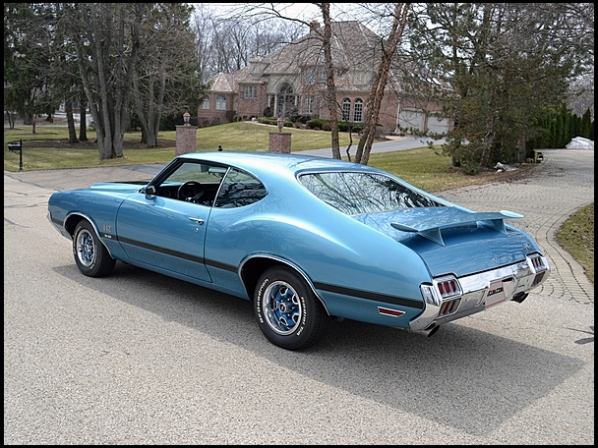 For those who tell me I rarely follow-up on my posts here is an update on recent writings. The Mecum Auction is underway and while still far from over there have been a couple of vehicles to cross the block of note. First would be this 1972 Oldsmobile 442 with its original 455 W30 package. Prior years were the top performance vehicle you could buy in an Oldsmobile Dealership. The 1972 could also be said the same thing despite being less “performance” than it’s predecessors due to the regulated compression loss for model year 1972. This was the final year for the body style and this vehicle had the bucket seat interior and was quite nice as far as condition. Most fans of the 442 view the 1970-1972 the best looking of the 442 lineage. This car sold for $22,500. That equates to less than half what a 1971 442 with a W30 package would cost. They routinely run upwards of $80,000 in this kind of condition.
For those who tell me I rarely follow-up on my posts here is an update on recent writings. The Mecum Auction is underway and while still far from over there have been a couple of vehicles to cross the block of note. First would be this 1972 Oldsmobile 442 with its original 455 W30 package. Prior years were the top performance vehicle you could buy in an Oldsmobile Dealership. The 1972 could also be said the same thing despite being less “performance” than it’s predecessors due to the regulated compression loss for model year 1972. This was the final year for the body style and this vehicle had the bucket seat interior and was quite nice as far as condition. Most fans of the 442 view the 1970-1972 the best looking of the 442 lineage. This car sold for $22,500. That equates to less than half what a 1971 442 with a W30 package would cost. They routinely run upwards of $80,000 in this kind of condition.
The 1966 Fairlane 500 with its 289 listed in an earlier post sold for a very reasonable $14,000 which is well under what the value should be. Nice purchase for someone. The 1971 Red Corvette Convertible got a high bid of $10,000 and did not sell. The deal with any auction is that you need the right buyer for a vehicle or nobody will sell anything. Same deal with the Green 1967 Dodge Coronet with the “Hemi Hood” which with a high bid of $12,000 was well under what anyone would sell this car for. Check previous posts for pictures of these 2 since I see no need to repost photos.
 A pleasant surprise would be this 1965 Ford Mustang Convertible. With its original 289 V8 engine it sold for a respectable $27,000. While you would imagine an original Convertible should sell for slightly more you need to realize that the 1965 Mustang sold 559,451 units with 73,112 being convertible versions. Add in the “1964 1/2” production of 126,538 with its 28,833 convertible copies and you have one of the few convertibles ever sold in excess of 100,000 copies. Normally early Mustang convertibles run closer to $22,000. Not outrageous but this shows where the market is headed and it is UP !
A pleasant surprise would be this 1965 Ford Mustang Convertible. With its original 289 V8 engine it sold for a respectable $27,000. While you would imagine an original Convertible should sell for slightly more you need to realize that the 1965 Mustang sold 559,451 units with 73,112 being convertible versions. Add in the “1964 1/2” production of 126,538 with its 28,833 convertible copies and you have one of the few convertibles ever sold in excess of 100,000 copies. Normally early Mustang convertibles run closer to $22,000. Not outrageous but this shows where the market is headed and it is UP !
 Makes me curious where this 1971 Chevrolet Camaro “Split Bumper” RS/Z28 with its 350 small block will end up.
Makes me curious where this 1971 Chevrolet Camaro “Split Bumper” RS/Z28 with its 350 small block will end up.
 Or better yet this 1970 Pontiac GTO Judge with its 400 cubic inch Ram Air 4 intake and 4 speed manual transmission. Only thing better would be if it had the 455.
Or better yet this 1970 Pontiac GTO Judge with its 400 cubic inch Ram Air 4 intake and 4 speed manual transmission. Only thing better would be if it had the 455.
Davey Boy
Tags:1965, 1966, 1967, 1970, 1971, 1973, 400, 440, 442, Automobiles, cars, Chevrolet, Chicago, Cutlass, detailing, drag racing, high return, investments, making money, money, Muscle Cars, Olds, Oldsmobile, Pontiac, profits, Trans Am, vehicle
Posted in Auctions, Automobiles, cars, current events, Investments, Muscle Cars, NFL, Racing, show cars, Uncategorized | Leave a Comment »
December 26, 2013
 As an “Internet Journalist” I have the opinion that people want to hear what I have to say. Now that does not mean you have to agree with me. And it certainly does not mean you need to hang on every word I say or follow along with any of my business practices. What it does mean is that I feel there is something I have to share and to enrich you or the automotive community as a whole.
As an “Internet Journalist” I have the opinion that people want to hear what I have to say. Now that does not mean you have to agree with me. And it certainly does not mean you need to hang on every word I say or follow along with any of my business practices. What it does mean is that I feel there is something I have to share and to enrich you or the automotive community as a whole.
This being said, the internet is full of companies claiming to give a journalist the platform to share his or her opinions with the promise of actually getting paid for it. The problem is those companies all seem to be blowing smoke when they make their claims. They want you to be a member for months and months before you qualify for payment then they give mere pennies while they rake in dollars. Typical B.S. for today’s society yet sooner or later it all comes to light and those Multi-Million or Multi-Billion Dollar companies end up being worth the mere pennies they pay out and the only person who makes money is the guy who started the business and then sold out to “Investors” who now own “Toilet Paper”. The actual “authors” move on to the next new deal and keep plugging away. To them it is the words that drive them not the profit. In the collector vehicle business the money is in the cars and the concepts behind buying and selling and even restoring them, not in writing about how it was done.
Enough of my rants and ramblings and onto the subject of discussion. The New Year is almost upon us and January means the “Auction Season” is here. As I have stated in the past… to most it means Arizona but to me it means Florida. The hype and “show biz types” tend to go local and stay in Arizona since it is in their area of the country. That is fine with me because there are more cars and more bargains in Florida at the Mecum Auction. This has grown to become the “Largest Auction” of the year with around 3000 cars crossing the auction floor. And that number is still climbing every year. The 1970 Mustang Convertible shown is up for sale this year. Even with its 302 V8, it makes a nice summer driver.
 Also crossing the block will be this 1986 Pontiac Trans Am with its 305 “tuned port” V8. These vehicles and ones from its era are gaining traction as “Collector Cars” due to the fact that in most states they are now “emission-exempt”. That means you are now able to retune or replace the engine without needing to install catalytic converters or smog devices. Despite the 200 to 300 horsepower available from “factory versions” of these, you can now legally get 400 plus from the GM small block V8’s without spending more than the value of the car. The added benefit of using this car over its 1960’s or 1970’s counterpart is that you gain better handling for the street or the track in stock form. You also get vastly improved brakes with discs VS. drums (for earlier versions). Third reason and most importantly for “new” collectors is that this car can be bought for around $10,000 in most parts of the country versus $20-30,000 for a “Bandit Trans Am” or even $50-60,000 for a first generation T/A.
Also crossing the block will be this 1986 Pontiac Trans Am with its 305 “tuned port” V8. These vehicles and ones from its era are gaining traction as “Collector Cars” due to the fact that in most states they are now “emission-exempt”. That means you are now able to retune or replace the engine without needing to install catalytic converters or smog devices. Despite the 200 to 300 horsepower available from “factory versions” of these, you can now legally get 400 plus from the GM small block V8’s without spending more than the value of the car. The added benefit of using this car over its 1960’s or 1970’s counterpart is that you gain better handling for the street or the track in stock form. You also get vastly improved brakes with discs VS. drums (for earlier versions). Third reason and most importantly for “new” collectors is that this car can be bought for around $10,000 in most parts of the country versus $20-30,000 for a “Bandit Trans Am” or even $50-60,000 for a first generation T/A.
 Then for the “hard-core gearheads” we get to a vehicle that probably represents a “Last Hurrah” for the Muscle Car Era. This is a 1971 Dodge Dart Demon GSS. The GSS designation is due to it being sold and equipped through “Grand Spaulding Dodge” which was better known as “Mr. Norms” dealership. Mr. Norm was a “Muscle Car Icon” during the time of the Muscle Car Era and vehicles left his dealership with certified “dynamometer” papers to show what they were putting out in the power department. He was the driving force behind several of Mopars “enhanced” models. Because of the fact his dealership would drop a bigger V8 into your new car even if the factory didn’t offer it, he was also a driving force behind the “Horsepower Wars” of the 1960-70’s. This particular car has the “Six-Pack” setup on its 340 cid engine. And because it is a Mopar with “history” it will probably sell for serious cash and deservedly so.
Then for the “hard-core gearheads” we get to a vehicle that probably represents a “Last Hurrah” for the Muscle Car Era. This is a 1971 Dodge Dart Demon GSS. The GSS designation is due to it being sold and equipped through “Grand Spaulding Dodge” which was better known as “Mr. Norms” dealership. Mr. Norm was a “Muscle Car Icon” during the time of the Muscle Car Era and vehicles left his dealership with certified “dynamometer” papers to show what they were putting out in the power department. He was the driving force behind several of Mopars “enhanced” models. Because of the fact his dealership would drop a bigger V8 into your new car even if the factory didn’t offer it, he was also a driving force behind the “Horsepower Wars” of the 1960-70’s. This particular car has the “Six-Pack” setup on its 340 cid engine. And because it is a Mopar with “history” it will probably sell for serious cash and deservedly so.
 Final car for this post is this 1970 Ford Torino Convertible. It retains its 351 Cleveland engine and 4 barrel carburation just as it left the factory with. The Torino does not get the following of the Mustang but it was Fords true “Muscle Car” representative. It was a midsize vehicle and every power option was available for it that Ford offered up to and including the 428 and 429 Cobra Jet engines. Add a top that comes down and for around half of what a Oldsmobile 442 hardtop or Buick GS 455 hardtop will cost you.
Final car for this post is this 1970 Ford Torino Convertible. It retains its 351 Cleveland engine and 4 barrel carburation just as it left the factory with. The Torino does not get the following of the Mustang but it was Fords true “Muscle Car” representative. It was a midsize vehicle and every power option was available for it that Ford offered up to and including the 428 and 429 Cobra Jet engines. Add a top that comes down and for around half of what a Oldsmobile 442 hardtop or Buick GS 455 hardtop will cost you.
So while these are only 4 of the 3000+ cars waiting to run through Mecums January Auction, they represent a wide range of what is out there. Happy bidding.
Davey Boy
Tags:1969, 1970, 1971, 351, Dart, demon, Dodge, Florida, Ford, GSS, Mecum, Mustang, Pontiac, T/A, Torino
Posted in Auctions, Automobiles, cars, current events, Investments, Muscle Cars, NFL, prototype cars, Racing, show cars, Uncategorized | 1 Comment »
December 23, 2013

 As the photo from the January 2008 Gooding Auction in Arizona depicts, the “Collector Car Hobby” is decidedly an “Old Caucasian Guy Hobby”. Therein lies the problem. Whether anyone likes it or not, and despite claims to the “increasing” health of the hobby of “Collector Vehicles”; there needs to be fresh blood or the “hobby” will eventually die. That is because the hobbyists are eventually going to die and as every auction has shown the heirs seem to be more interested in “cashing in” than they are in continuing the legacy that was started.
As the photo from the January 2008 Gooding Auction in Arizona depicts, the “Collector Car Hobby” is decidedly an “Old Caucasian Guy Hobby”. Therein lies the problem. Whether anyone likes it or not, and despite claims to the “increasing” health of the hobby of “Collector Vehicles”; there needs to be fresh blood or the “hobby” will eventually die. That is because the hobbyists are eventually going to die and as every auction has shown the heirs seem to be more interested in “cashing in” than they are in continuing the legacy that was started.
While everyone in the “hobby” dreams of finding that million dollar car that puts them on the map as a collector, most simply collect cars that mean something to them personally. The Auctions that come every January in Arizona are big draws for buyers as well as the casual fan of the “Old Cars”. But those over priced multi million dollar Ferrari’s and the like are not helping to draw anyone new into the hobby. A first time buyer sees the auctions on their Cable ( or Satellite ) Television feed and thinks these are what the “hobby” is all about. The truth is they amount to very little in actual count. There are somewhere around 10,000 cars a year that are run through “major” auctions and few draw the million dollars you see on television.
Average prices are closer to the $50,000 mark and even that is a steep price for admission to the hobby for a first time buyer. I don’t have a solution to the problem of getting new people into the hobby, except to say the way to grow the hobby is to bring in a bigger demographic for your base. That means “minorities”. Hispanics, Blacks, Asians, any minority. The Rappers and “Hip/Hop” artists seem to be into flashy big dollar vehicles that are new and the “Pro Athletes” are as well. Most Hispanics in my area are into vehicles that cost much less than the $50,000 for an average auction vehicle. I cannot count the number of $2000 cars I see daily with $3000 worth of rims and tires on them. Hispanics who are into cars still want “flash” but are on a budget it seems. The 1972 Ranchero with it’s 351 is a great choice for a vehicle with “Hispanic Appeal”. There are “Rappers” who are into cars as well. Snoop Dogg comes to mind with his Bonneville convertible and for athletes we have Reggie Bush with his Shelby Mustang to name 2 off the top of my head, but there is a serious shortage of “Color” in the collector ranks. And that needs to change.
I would like to partner with someone who belongs to a “minority” to put a new “face” on the hobby and bring this “Collector Car Business” to a whole new level.
davey boy
Tags:1972 Ranchero, Arizona, Asians, Auction, Blacks, Ford, Gooding, Hispanics, Minorities
Posted in Auctions, Automobiles, cars, current events, Investments, Muscle Cars, NFL, prototype cars, Racing, show cars, Uncategorized | Leave a Comment »
December 14, 2012
After enjoying this Woodie Wagon for about the last 5 years and during that time doing the previously neglected maintenance to bring it back to daily driver reliability: my friend Jim is finally putting his car up for sale.
 It is a 1946 Pontiac Streamliner 4 door Woodie Wagon. It has its original Straight 8 cylinder flathead engine with its original 3 speed manual trans (column mount shift of course), and its original 6 volt electrical system. The vehicle is 100% solid with no rust through now or ever in its body panels. The stainless trim is in great shape and chrome is really good condition. It has a new starter, carburetor, generator, front shocks, bushings, pins and arms. New professionally done vinyl roof and interior carpets. The wood is all original NOT replaced – and in very decent shape. If it was ever repainted it was long ago and the paint is decent with a couple of rock chips and minor blemishes, but no HOLES.
It is a 1946 Pontiac Streamliner 4 door Woodie Wagon. It has its original Straight 8 cylinder flathead engine with its original 3 speed manual trans (column mount shift of course), and its original 6 volt electrical system. The vehicle is 100% solid with no rust through now or ever in its body panels. The stainless trim is in great shape and chrome is really good condition. It has a new starter, carburetor, generator, front shocks, bushings, pins and arms. New professionally done vinyl roof and interior carpets. The wood is all original NOT replaced – and in very decent shape. If it was ever repainted it was long ago and the paint is decent with a couple of rock chips and minor blemishes, but no HOLES.
I realize this is NOT a Muscle Car and only put these pictures on here so you understand where a lot of my time has gone lately. It has been to help get the Pontiac ready for market. Any one looking for a really nice Woodie let me know. By the way the 1946 models were the first year car production resumed after WWII. There were no cars made during the war.
Davey Boy (more…)
Tags:1946, 1957, 1964, 1965, 1966, 1967, 1968, 1969, 1970, 400, 6 volt, Automobiles, cars, Chicago, collector vehicle, detailing, high return, investments, making money, money, Muscle Cars, Olds, Oldsmobile, Pontiac, straight 8, Streamliner, Torpedo, vehicle, Woodie Wagon
Posted in Auctions, Automobiles, cars, current events, Investments, Muscle Cars, NFL, prototype cars, Racing, show cars, Uncategorized | Leave a Comment »
January 9, 2011
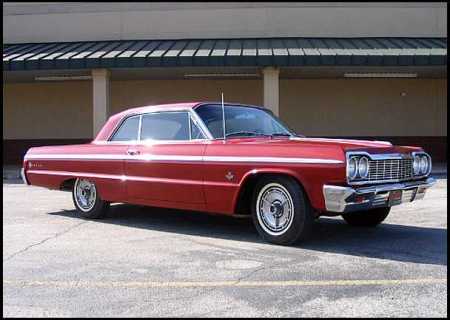 This would be a 1964 Impala SS. This is the car that the Beach Boys wrote the song “She’s Real Fine, My 409” about. It has the 409 cubic inch big block motor. While not a dual carb setup, it was and still is a potent performer and worthy of its own song. The 1964 Impala has the distinction of being the “Best Selling” car model ever made as it sold 1,074,925 copies in 1964 alone. This feat is even more amazing when you consider that they totally redesigned the Impala in 1965 and that car holds the number 2 spot at 1,046,500 copies.
This would be a 1964 Impala SS. This is the car that the Beach Boys wrote the song “She’s Real Fine, My 409” about. It has the 409 cubic inch big block motor. While not a dual carb setup, it was and still is a potent performer and worthy of its own song. The 1964 Impala has the distinction of being the “Best Selling” car model ever made as it sold 1,074,925 copies in 1964 alone. This feat is even more amazing when you consider that they totally redesigned the Impala in 1965 and that car holds the number 2 spot at 1,046,500 copies.
 This was one of the facts behind the Chevrolet Division at General Motors being slow to respond to the introduction of the GTO model over at Pontiac.
This was one of the facts behind the Chevrolet Division at General Motors being slow to respond to the introduction of the GTO model over at Pontiac.
The GTO in 1964 caused a stir in the automotive community and the car manufacturer’s scrambled to come up with their own performance models. But Chevrolet, through its own arrogance as the #1 division at General Motors felt their Impala with its Super Sport model had already established the Muscle image they needed. And better yet they did it with the heavyweight class, not the welterweight division. After all, why would the car buying public want to drive a “Prince” when they could have the “King”? And as a company, why would they want to earn a couple hundred dollars when they could earn double on a “full-size” vehicle. Chevrolet had the Corvette model which was a true sports car, and they had the Corvair which was designed to compete against the European sports cars. With the full size Impala carrying the Performance torch for the division with the American family, why would they need to claim the title for the junior league as well?
 The 1965 Chevelle Malibu SS 327 had the engine from the standard model Corvette although slightly detuned it was the venerable 327 from it’s “sports” car. Oldsmobile responded to the 389 powered GTO in 1965 by upping the ante with its 345 horsepower 400 cubic inch power plant being installed in the 442.
The 1965 Chevelle Malibu SS 327 had the engine from the standard model Corvette although slightly detuned it was the venerable 327 from it’s “sports” car. Oldsmobile responded to the 389 powered GTO in 1965 by upping the ante with its 345 horsepower 400 cubic inch power plant being installed in the 442.
 The 442 model now stood for 400 cubic inches, four barrel carb, and dual exhaust. Despite in my opinion a rather stodgy design it was a good performer and put the Oldsmobile division on par with Pontiac in the new Muscle Car marketplace.
The 442 model now stood for 400 cubic inches, four barrel carb, and dual exhaust. Despite in my opinion a rather stodgy design it was a good performer and put the Oldsmobile division on par with Pontiac in the new Muscle Car marketplace.
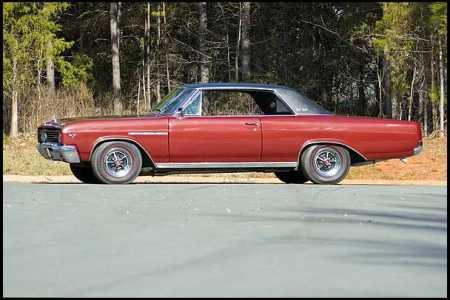 In 1965 Buick finally came into the marketplace with its Buick Skylark Gran Sport. This was the version of the Special model with the Buick “Nailhead” 401 cubic inch motor. Due to new rules limiting the engine size to 400 CID for midsize vehicles, Buick simply listed the engine as a 400 on its literature.
In 1965 Buick finally came into the marketplace with its Buick Skylark Gran Sport. This was the version of the Special model with the Buick “Nailhead” 401 cubic inch motor. Due to new rules limiting the engine size to 400 CID for midsize vehicles, Buick simply listed the engine as a 400 on its literature.
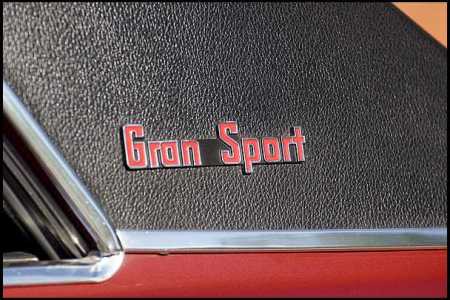 For the sake of clarity the GS as these cars would come to be known did not stand for Grand Sport, it was Gran Sport. Buick made GS or Gran Sport versions of almost all its models, partly because the management did not want to miss the boat for the next wave of performance buyers. They had a Riviera GS as well as the Wildcat GS which moved them into the 425 CID “Wildcat” engines since they were larger vehicles and the displacement restrictions did not apply.
For the sake of clarity the GS as these cars would come to be known did not stand for Grand Sport, it was Gran Sport. Buick made GS or Gran Sport versions of almost all its models, partly because the management did not want to miss the boat for the next wave of performance buyers. They had a Riviera GS as well as the Wildcat GS which moved them into the 425 CID “Wildcat” engines since they were larger vehicles and the displacement restrictions did not apply.
With Pontiac laying claim to being the “Original” muscle car and both Oldsmobile and Buick now pushing big block engines and their massive power, it was finally time for Chevrolet to either throw in the towel or answer the bell.
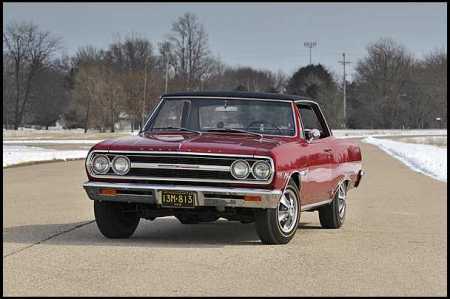 So answer they did. It was the Chevelle Malibu SS396. It would go on to become a true legend. The original 1965 versions were built on the stiffened convertible chassis because of concerns over the engines massive torque compared with the small block engine. This was a lesson picked up from the Pontiac division since all GTO’s were also built on different frames than the Tempest and LeMans models. This also meant these cars had their own VIN number and as a result makes them “easier” for collectors to identify as such today. In the case of the GTO there is also a frame identification to use for verification.
So answer they did. It was the Chevelle Malibu SS396. It would go on to become a true legend. The original 1965 versions were built on the stiffened convertible chassis because of concerns over the engines massive torque compared with the small block engine. This was a lesson picked up from the Pontiac division since all GTO’s were also built on different frames than the Tempest and LeMans models. This also meant these cars had their own VIN number and as a result makes them “easier” for collectors to identify as such today. In the case of the GTO there is also a frame identification to use for verification.
The 1965 Chevelle Z16 SS, as it was known due to the engine designation, was however limited its first year of production. A handful of prototypes such as the one pictured here and another 201 were all that was made in 1965. They are among the rarest and most valuable muscle cars today. This prototype sold a couple of years back for around $375,000. Not bad for a car costing around $3500 new.
This covers the General Motors end of the 1965 model year as pertains to the “Muscle Car” segment, and there are more than just GM vehicles to show you, but the others will have to wait for the next installment. After all, I need you to keep reading this blog. So, later all. Thank-you for stopping by and more in about a week.
Davey Boy
Tags:1964, 1965, 1966, 396, 400, 401, 442, 454, Automobiles, Big Block, Chevrolet, Chicago, Cutlass, detailing, drag racing, General Motors, GM, GTO, high return, Impala, investments, money, Muscle Cars, NHRA, Nova, Olds, Oldsmobile, Pontiac, profits, SS396, Super Sport, Z16
Posted in Auctions, Automobiles, cars, current events, Muscle Cars, NFL, Racing, Stalker, Uncategorized | 56 Comments »
December 24, 2010
 Just a short posting this time. It is Christmas Eve, so I have a lot of stuff to accomplish before the day is over. This time I have decided to give those who care my current “Christmas List” of vehicles. Just in case anyone out there cannot decide what to get me.
Just a short posting this time. It is Christmas Eve, so I have a lot of stuff to accomplish before the day is over. This time I have decided to give those who care my current “Christmas List” of vehicles. Just in case anyone out there cannot decide what to get me.
First we have the 1971 Plymouth GTX. Make sure it has the 440 and preferably the 6-Pack carb setup on it, but in a pinch, and since this is short notice the 4 barrel setup is also acceptable. The 1971 GTX was a new body style that had some added style to it compared to the 1970 with its slab sides and box styling. It should be a bucket seat interior with a 4 speed transmission as well. Don’t bother with the A/C option because when the temperature is 90 degrees or over, it won’t be driven since these Mopars are notorious for running hot in hard-driving.
What’s the point in having to sit in a parking lot waiting for the engine to cool down ? The version here also has an Air Grabber intake hood and air cleaner which makes it cost a few thousand more. But I never claimed to be a cheap date.
 These are not in any prefered order so any will be a fine choice for me. Next we come to a 1969 Pontiac Firebird 400 Convertible. It has to be a convertible because this one will be driven in hot weather also, unlike the GTX. Automatic transmission is also okay for this little screamer. The Camaro SS/RS with a 396 can be substituted, and those are more plentiful but will cost almost double or even triple what a Firebird will. Just trying to save you some cash people.
These are not in any prefered order so any will be a fine choice for me. Next we come to a 1969 Pontiac Firebird 400 Convertible. It has to be a convertible because this one will be driven in hot weather also, unlike the GTX. Automatic transmission is also okay for this little screamer. The Camaro SS/RS with a 396 can be substituted, and those are more plentiful but will cost almost double or even triple what a Firebird will. Just trying to save you some cash people.
 Then there is the 1970 Mercury Cyclone with the 429 Cobra Jet engine. There are several upgrades that can be added to the Cyclone. It could be a “GT” model or the “Spoiler” model and any will be fine with me. The Cyclone was based on the Montego model which was based on the Ford Torino, but the Torino never had the cache that a Cyclone did with the Muscle Car Crowd.
Then there is the 1970 Mercury Cyclone with the 429 Cobra Jet engine. There are several upgrades that can be added to the Cyclone. It could be a “GT” model or the “Spoiler” model and any will be fine with me. The Cyclone was based on the Montego model which was based on the Ford Torino, but the Torino never had the cache that a Cyclone did with the Muscle Car Crowd.
This is a vehicle that looks good in almost any color, whether it be Baby Blue, Yellow, White, Black, Blue, Red….it really does not matter.
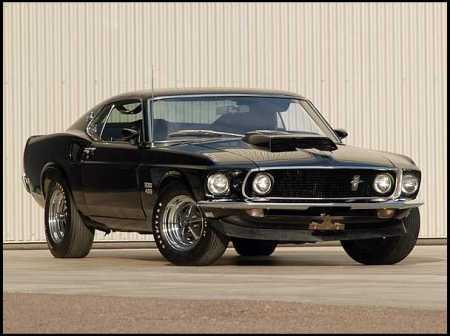 For any “High-Rollers” that are out there the next choice will be up to you guys to buy. That would be the 1969 Ford Mustang Boss 429. This car will set someone back $150,000 or more.
For any “High-Rollers” that are out there the next choice will be up to you guys to buy. That would be the 1969 Ford Mustang Boss 429. This car will set someone back $150,000 or more.
I refer back to the “I am not a cheap date” quote from earlier. This is the closest car to a factory built NASCAR vehicle you can find, even though the Mustang was not used in NASCAR.
Several tricks were used to actually make the heavy engined vehicle better balanced such as wider front suspension geometry and relocating the battery to the trunk and much beefier suspension up front. This would be an under 90 degree driver as well as the GTX. But that is what I will have to deal with and it is a challenge that I will gladly accept.
 The Boss 429 was made in 1969 and 1970 so either will be fine. For those who want to get me the 69 or 70 Mustang but cannot quite afford the price of a “Boss”, I will accept a Mach I with the 428 as well.
The Boss 429 was made in 1969 and 1970 so either will be fine. For those who want to get me the 69 or 70 Mustang but cannot quite afford the price of a “Boss”, I will accept a Mach I with the 428 as well.
Here we have the 1970 version with the 428 Cobra Jet engine. While only 1 cubic inch smaller in displacement it is about 100 horsepower less as well, due to the special pieces in the 429 Boss engine. That is alright with me because it is the thought that counts when someone buys me a gift. I can still wreak havoc on the city streets with the Mach I.
 The final choice for this list will be a 1971 Oldsmobile 442.
The final choice for this list will be a 1971 Oldsmobile 442.
Preferably a convertible. Automatic transmission is fine with me and although this is a 1971, I will take any year from 1969 through 1971. The version here is the W30 model. The engine is a special motor built by Oldsmobile with special heads, carb and exhaust as well as major mods to engine internals. This engine along with the Buick 455 used in its GSX have the distinction of having the highest torque of any engines built during the Muscle Car years. 500 foot pounds of torque was the claimed number and nobody else cracked the 500 mark back then.
So anyway…..that is my list. Everybody have a safe and joyous Christmas and enjoy some time with your families. God Bless all of you and thanks for following my blog.
Davey Boy
Tags:1967, 1968, 1969, 1970, 1971, 440, 442, 454, AMC, AMX, Automobiles, cars, Chevrolet, Chicago, Cutlass, high return, investments, making money, money, Muscle Cars, NHRA, Nova, Olds, Oldsmobile, Pontiac, profits, SS396, Trans Am
Posted in Auctions, Automobiles, cars, current events, Muscle Cars, NFL, Racing, Uncategorized | 1 Comment »
August 29, 2010
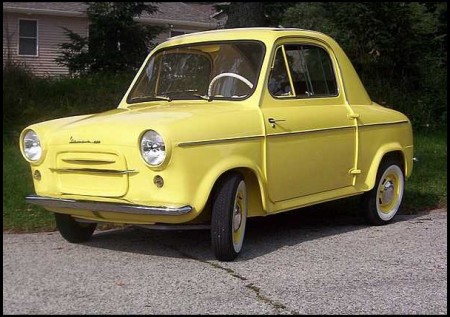 Here’s an “economy” car for those who favor European performance. Okay that would be a stretch, but what we have here is a 1961 Vespa 400. Nice little car you won’t find too many of at your next car show. You may know of Vespa as the “moped” people and you are correct, but they made cars at one time also. I do not know if they still do…..my guess would be no because I never see them tooling the highway but then a lot of European manufacturers do not export cars to the United States, so I cannot be certain.
Here’s an “economy” car for those who favor European performance. Okay that would be a stretch, but what we have here is a 1961 Vespa 400. Nice little car you won’t find too many of at your next car show. You may know of Vespa as the “moped” people and you are correct, but they made cars at one time also. I do not know if they still do…..my guess would be no because I never see them tooling the highway but then a lot of European manufacturers do not export cars to the United States, so I cannot be certain.
It was one of the cars that had the soft roll-back top which gave the effect of being a convertible, without losing the chassis rigidity from not having a solid roof. At least that was the line car makers used back in the days.
As you can see in the third picture it was called a 400 because it used a 400 cc engine. The generator is almost as big as the motor, and you can clearly see the “massive” fuel tank sitting beside the engine on the left hand side. This vehicle will be at the Mecum Auction in St. Charles, Illinois that runs September 16th through the 19th. It is held at the Pheasant Run Resort. It is the Largest annual auction in the Chicagoland area and they expect over 1000 cars this year.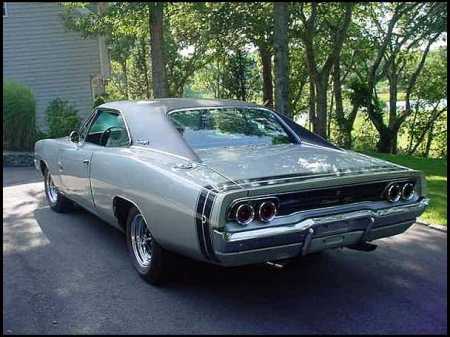
There must be a lot of people thinking the bottom of the market for these collector cars has been reached because some highly significant cars are coming up for auction. This is 1 of only 475 R/T Chargers built with the 426 hemi engine in 1968. And it is a rare Silver color on top of that.
While the hemi’s draw the attention and the big money, I prefer the 440 such as this 1969 Charger has under the hood. One of the vehicles getting rarer every year as a lot of these 1969’s keep getting cloned into “General Lee” editions every year. Either way you prefer your Mopar they will have a lot of them at St. Charles.

One of the sweetest rides would be this 1970 Dodge Challenger convertible. It may only have a 340 under the hood, but top down cruising more than makes up for the engine displacement. The Challengers will appreciate slightly ahead of the curve in future years I feel because they are valued less than their flashier twin the ‘Cuda/Barracuda from Plymouth. The Challenger rode on a wheelbase that was 2 inches longer than the ‘Cuda.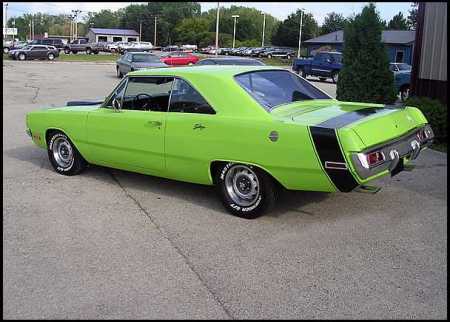
The “Go Go Green” car is the 1970 Dodge Dart Swinger with a 360 motor and if the 340 equipped Challenger is too tame for you, this little beast will fit you better. The older style 1968 Dart with the 426 Hemi is still setting Drag Strip records 42 years later. It is a shame the factory only produced 50 of them.
The compact Dart was the direct competitor to the Chevrolet Nova, but unlike the Nova, the Dart used a full frame beneath it. From a performance standpoint, the Dart could handle double the horsepower that the Nova could without major chassis modifications.
The major knock with Mopars during the late 60’s and early 70’s was their use of attention-getting paint colors. It was hard to blend into the crowd with a bright green or a pink car. And if running the city streets was your thing back then, the attention from “Johnny Law” was something you did not want.
Then we come to a 1971 Plymouth ‘Cuda equipped with a 340 engine. The blacked out “patches” on the rear quarters were called “billboards” and they gave the engine size for people to see when you drove by. The 340 was the lowest number used in “billboards” as the factory saw no reason to advertise the base 318. But above the 340, there was 360, 383, 440, 440-6 (which designated the 6-pack carb set up), and of course HEMI which would be the most feared engine you could put in a Mopar.
Well, besides these few Mopars shown here there is another 20 pages on the Mecum web site to check out if you feel so inclined. And they have a lot of Chevrolet, Ford, Pontiac, AMC, and on and on. This sale specializes in Muscle Cars and nobody does it as well as Mecum. You can check out their web site at www.mecum.com
My advise is to be sure and sign up for their infonet service so you can get auction notifications and check out past auctions with pricing information.
Later my friends….. follow me on Twitter…. i am….. dwayne1957
davey boy
Tags:1965, 1967, 1968, 1969, 1970, 1971, 440, 442, 454, AMC, Automobiles, Chevrolet, Chicago, Cuda, detailing, Dodge, drag racing, high return, investments, money, Mopar, Muscle Cars, NHRA, Nova, Olds, Oldsmobile, Plymouth, Pontiac, profits, SS396, Trans Am, vehicle
Posted in Auctions, Automobiles, cars, current events, Muscle Cars, NFL, Racing, Uncategorized | 5 Comments »




 When the final year for the “original style Camaro came around the model year was 1969, and despite the “454” emblems on the pictured car it was not a “factory choice” back then. The cubic inch limit remained the 396 for big blocks other than a handful of “COPO vehicles” that snuck through.
When the final year for the “original style Camaro came around the model year was 1969, and despite the “454” emblems on the pictured car it was not a “factory choice” back then. The cubic inch limit remained the 396 for big blocks other than a handful of “COPO vehicles” that snuck through. For the redesign in 1970 (technically known as 1970 1/2 for collectors) not everyone liked the new style. Production had been 230,799 Camaros for 1969 and fell to 117,604 for 1970. Collectors all try to explain the big drop to a limited production run due to a labor strike, but facts are that the 1971 production fell to 107,496 and then in 1972 it went even lower to 68,656. So no matter if you are a fan of the redesign or not- most buyers at that time were not.
For the redesign in 1970 (technically known as 1970 1/2 for collectors) not everyone liked the new style. Production had been 230,799 Camaros for 1969 and fell to 117,604 for 1970. Collectors all try to explain the big drop to a limited production run due to a labor strike, but facts are that the 1971 production fell to 107,496 and then in 1972 it went even lower to 68,656. So no matter if you are a fan of the redesign or not- most buyers at that time were not.
 Their new design was this. 1 inch more in wheelbase; it was now 109 instead of 108. (The Camaro did not change their wheelbase from the 108 in 1969.) Where it grew ever slightly was also the overall length- from 187.4 inches to 190 even. The biggest gain was the width from 71.7 to 75. All that rear sheetmetal also raised the base weight almost 180 pounds. The look made the Mustang seem much larger than it really was. To buyers or those who test drove it there were glaring deficiencies with the design.
Their new design was this. 1 inch more in wheelbase; it was now 109 instead of 108. (The Camaro did not change their wheelbase from the 108 in 1969.) Where it grew ever slightly was also the overall length- from 187.4 inches to 190 even. The biggest gain was the width from 71.7 to 75. All that rear sheetmetal also raised the base weight almost 180 pounds. The look made the Mustang seem much larger than it really was. To buyers or those who test drove it there were glaring deficiencies with the design.


































